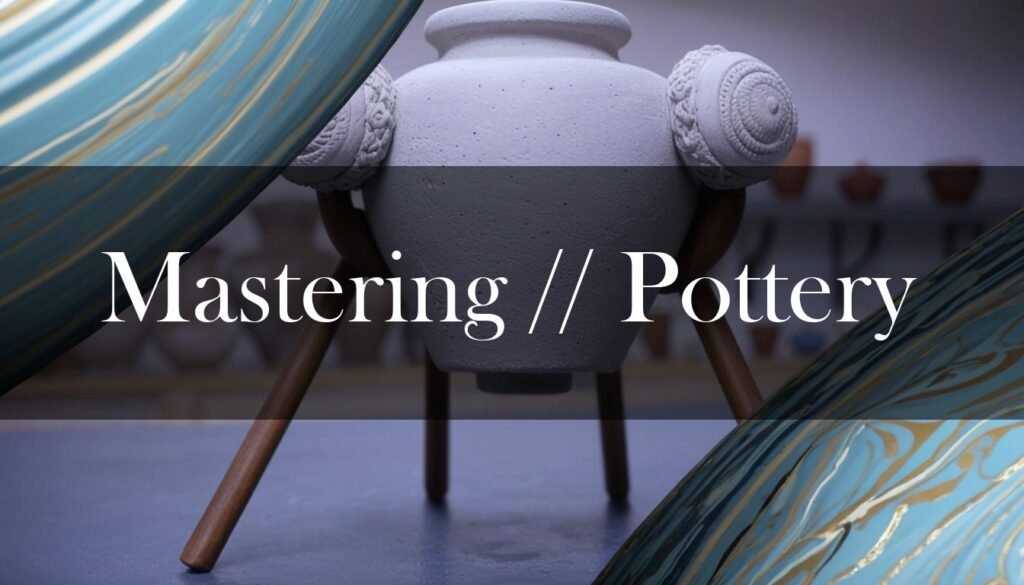Throwing large forms on the pottery wheel can be an incredibly rewarding experience, allowing you to create impressive and substantial ceramic pieces. However, it also presents unique challenges that require careful attention to technique, clay selection, and drying methods. Let’s explore some of the common hurdles you might encounter and how to overcome them, ensuring your journey into large-scale pottery is both successful and enjoyable.
One of the first obstacles many potters face is centering a large amount of clay. This requires more than just strength; *it’s about technique and understanding the clay’s properties*.
Claire O’Connor suggests using softer clay and throwing it drier to prevent it from becoming overly saturated and weak, you can read more about it in this article about throwing smarter and stronger. Inadequate wedging can also lead to frustrating air pockets that make centering nearly impossible, to learn more, you can read this article about problems centering clay. Remember, proper wedging is crucial to remove air and create a homogenous clay body. Overusing water is another common pitfall, weakening the clay structure and causing it to collapse. Instead, use minimal water and consider a clay-slip for lubrication, as is talked about in this article about throwing large pots on the pottery wheel.
When lifting the walls, avoid relying solely on your fingertips, which can lead to uneven lifts and wobbly rims. Use your knuckles or the heel of your hand for better control and stability, as is talked about in this article about throwing large pots on the pottery wheel. Also, be mindful of excess clay at the bottom; work it up the walls to achieve the desired height, as explained in this article on throwing taller pots on the pottery wheel.
Choosing the right clay body is essential for large-scale work. Stoneware clay is often recommended due to its durability and ability to hold its shape during firing, as is explained in this article on what clay is best for pottery. To further enhance the clay’s workability, consider adding grog, sand, or wollastonite. These additives reduce shrinkage and minimize the risk of cracking. For instance, Laguna Clay’s “Big White” (WC381), containing 60 mesh sand and 30 to 60 mesh grog, is excellent for hand-building large forms, to learn more, check out this forum on claybodies for large scale ceramics.
Paper clay, a blend of clay and paper fibers, is another great option, offering extra strength, reduced weight, and decreased cracking during drying, according to this article on different types of clay.
In terms of tools, a heavy-duty potter’s wheel is a must, along with adjustable stools for maintaining good posture. Large bats and bat systems provide a stable base, while sturdy ribs and extended throwing sticks aid in shaping the clay, as can be seen in this selection of throwing tools. Don’t forget heavy-duty wire clay cutters, large sponges, calipers, paddles, and trimming tools to refine your piece. You may also want to read this article about pottery tools.
Once you’ve thrown your large piece, drying it evenly is critical to prevent cracking. Slow and controlled drying is key. Cover the pottery loosely with plastic to retain moisture, ensuring the plastic doesn’t touch the clay directly, as explained in this article on hints for even drying. A damp box can also provide a humid environment for controlled drying, according to this article on drying pottery without cracks.
Ensure even air circulation by elevating the pottery on a wire rack and rotating it periodically, according to this article on drying pottery and this article on preventing pottery clay from cracking while drying. Pay special attention to vulnerable areas like handles and rims, wrapping them with plastic or damp cloths to slow their drying rate, as is mentioned in this article on hints for even drying. Using absorbent surfaces like plaster bats can also help draw moisture evenly, according to this article on drying shrinkage. To improve your clay drying practices, you may also want to read this article about mastering clay storage.
Drying pottery is one of the most important steps in the entire process. Without the correct process, the entire piece can fail, and weeks of work can be ruined.
Finally, consider the decorative techniques that will best complement your large form. Coiling and relief work, as practiced by Muqbil Al-Zahawi, can add unique textures and shapes. Texturing with natural and found objects offers endless creative possibilities, as shown in this article on impressing patterns in clay. Advanced glazing techniques, such as layering different glazes, can create complex and vibrant surfaces, according to this article on advanced pottery techniques.
Slipware and sgraffito, carving and incising, burnishing and terra sigillata, and alternative firing techniques like raku can all add character and visual interest to your large pottery forms, as can be seen in this article on ceramic art, this article on pottery and this article on ceramic sculptures. By carefully addressing the challenges and embracing the possibilities, you can create stunning large-scale pottery that showcases your skill and creativity.





